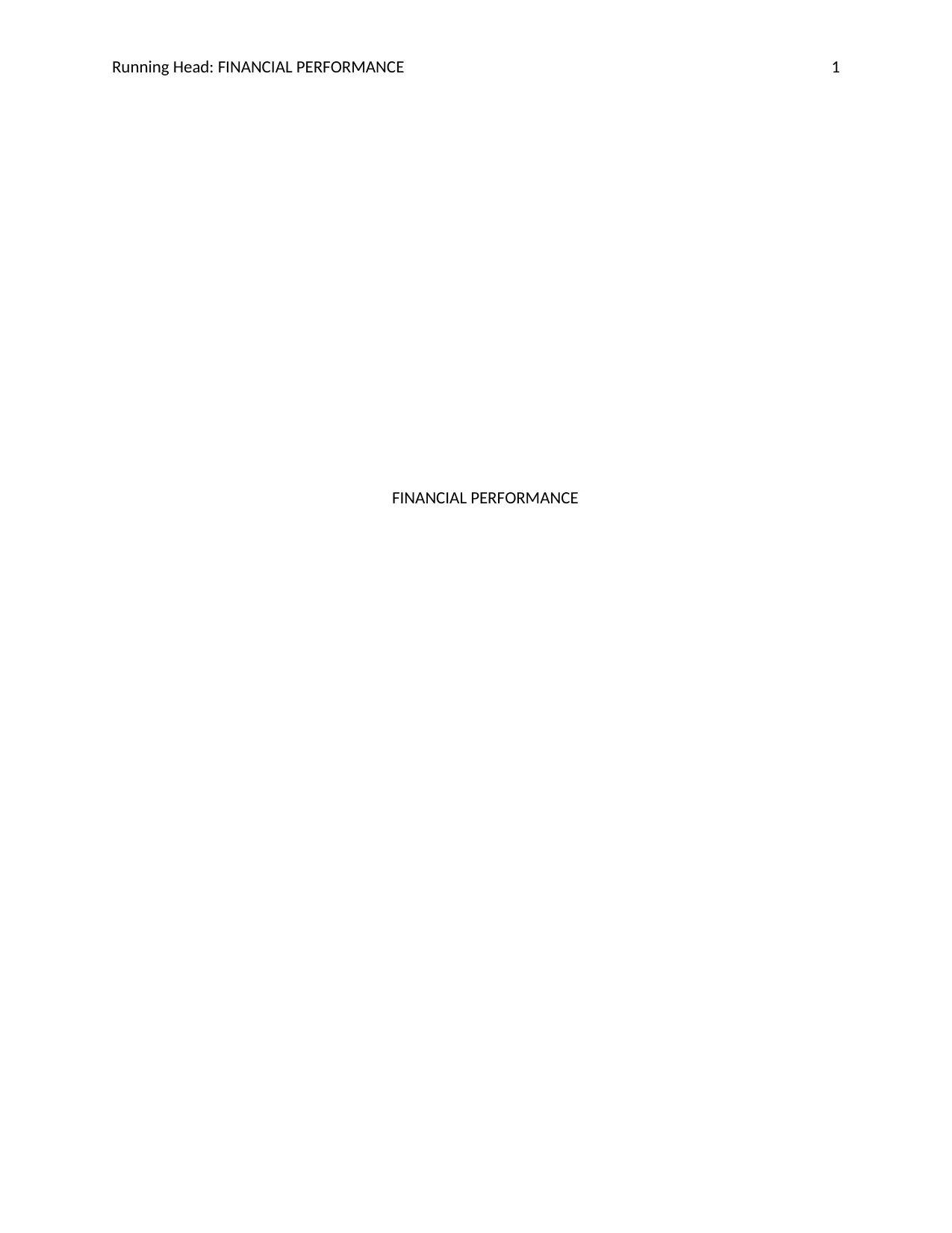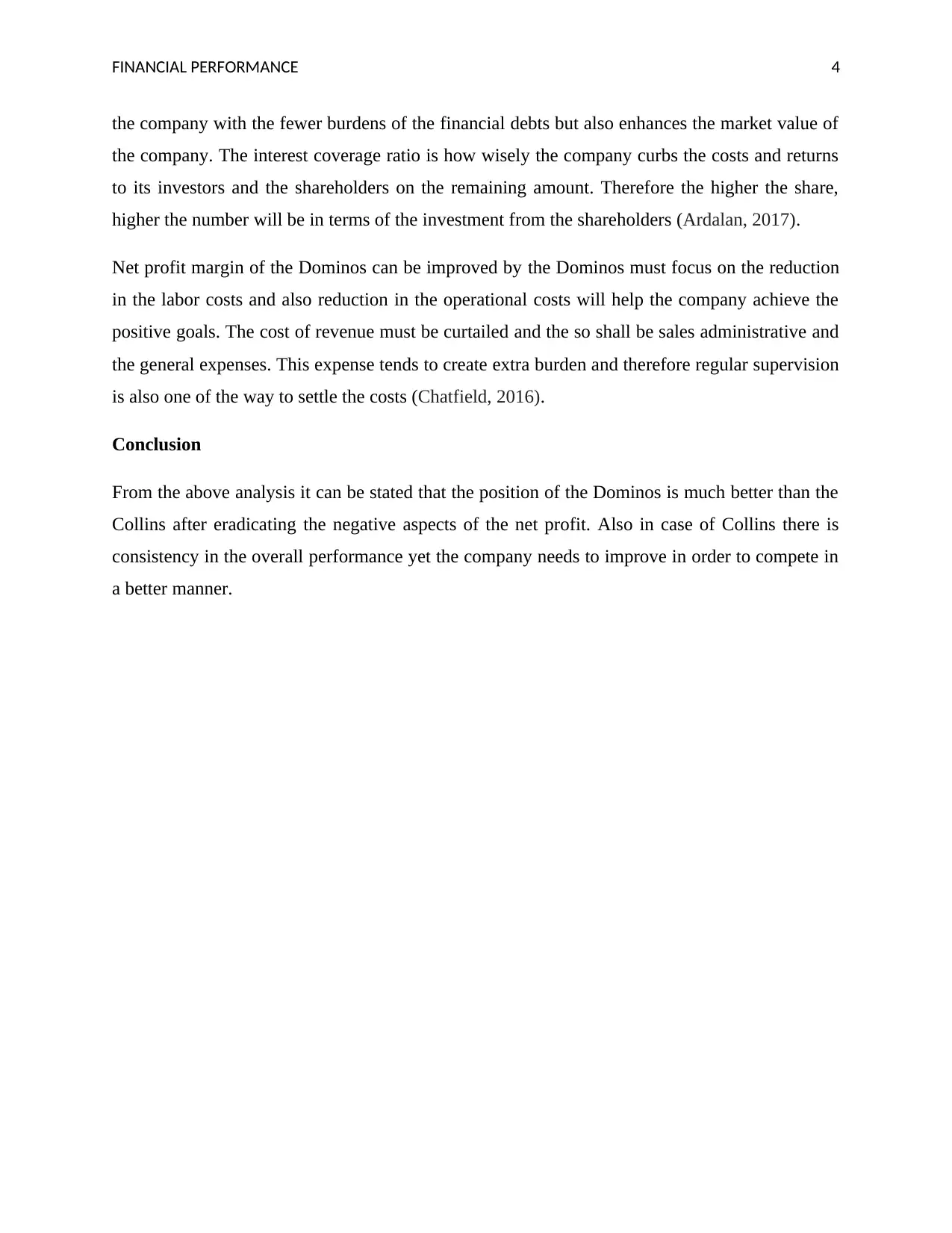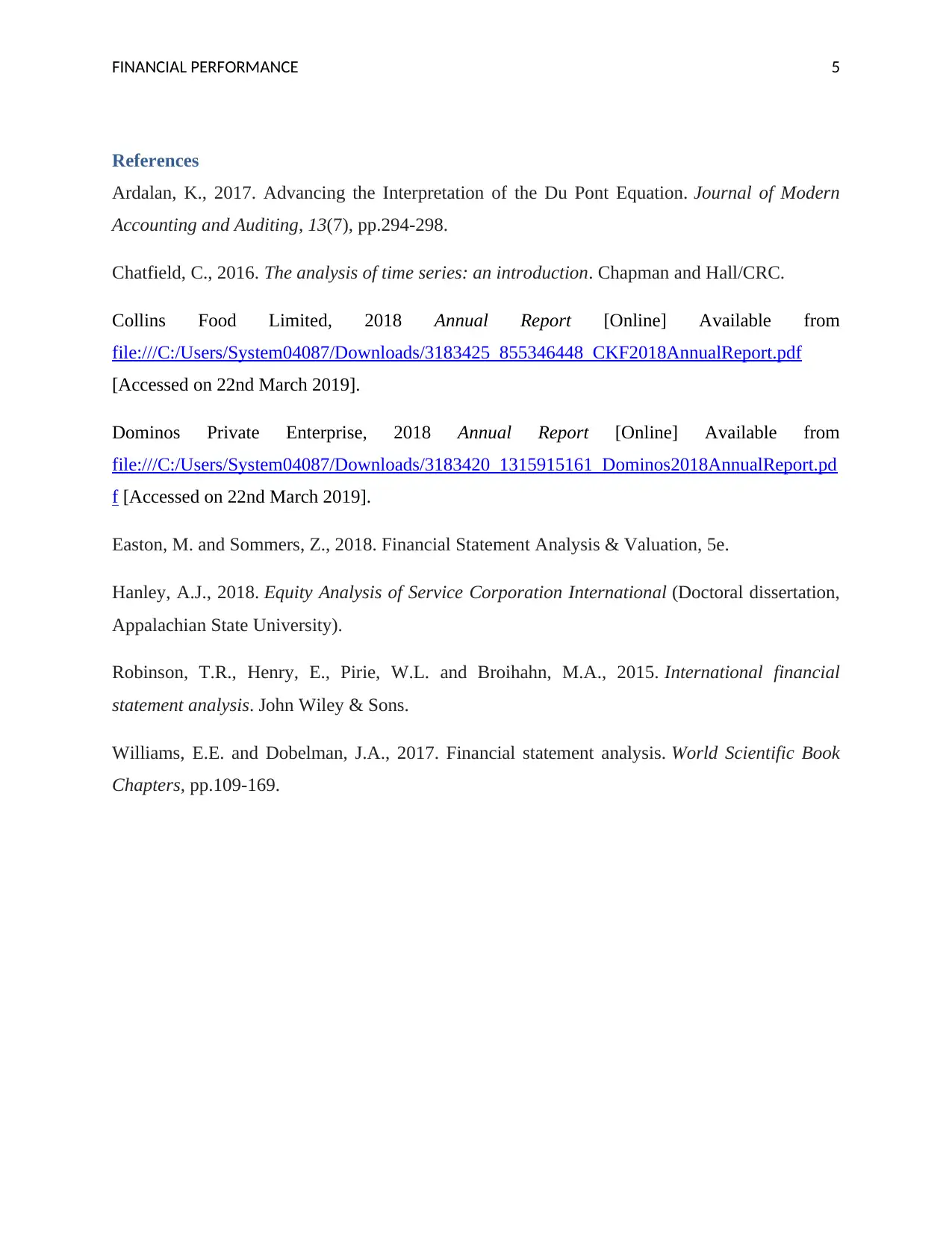Financial Performance
VerifiedAdded on 2023/04/10
|5
|1081
|490
AI Summary
This essay provides a detailed analysis of the financial performance of Collins Food and Dominos Company using ratio analysis and trend analysis. It compares their revenue, net income, and employee performance. The essay also discusses the limitations of both companies and provides recommendations for improvement.
Contribute Materials
Your contribution can guide someone’s learning journey. Share your
documents today.

Running Head: FINANCIAL PERFORMANCE 1
FINANCIAL PERFORMANCE
FINANCIAL PERFORMANCE
Secure Best Marks with AI Grader
Need help grading? Try our AI Grader for instant feedback on your assignments.

FINANCIAL PERFORMANCE 2
Introduction
In this essay a detailed analysis of the Collins food and Dominos Company is carried out in order
to determine the financial performance of the companies. This procedure is carried out to find
out if the company is hiding anything or not. Further to find out the root cause of the same there
are some techniques that have been used namely the ratio analysis, the trend analysis majorly the
vertical analysis and lastly the overall scrutiny on the notes presented in the balance sheet
(Easton and Sommers, 2018).
Body
Collins Food Limited is an Australian Limited company whose main focus is static on the
restaurant operations. The best feature of this company is how well they are operating the
restaurant chains like KFC and Sizzler (Collins Food Limited, 2018). On the other hand
Domino’s Pizza is the largest pizza chain also based in Australia, who is running the largest
franchisee in the name of Domino’s Pizza. DPE is the exclusive master franchise in France,
Netherlands, Belgium, Australia and New Zealand. In terms of comparison the revenue of the
Collins food limited is $770396 and that of the Dominos Private Enterprise is $794072 in the
financial year 2018. This leads to the net income of $32489 and $21693 respectively. In terms of
the employee performance the number of employees is 9181 in the Collins team and that of the
Dominos are 26000 (Dominos Private Enterprise, 2018).
Literature view
According to Robinson Henry Pirie and Broihahn (2015) the ratio analysis is an important
technique that is used to measure the financial performance of the business and it is important to
note that the investors are keen to know how the companies are performing and therefore this
technique is made suitable for determining which company is better and why. In terms of the
profitability the net profit of the Collins Company is within the range of 4.77% to 5.23% and
secondly in comparison to DPE the net profit ratio is 2.73% this is the huge difference from the
previous year where the net profit ratio was 13.38%.
In oppose to this Easton and Sommers (2018) stated that the leverage ratios of the Collins and
the Dominos Private Enterprise faced the extreme level down points as the Collins are not able to
Introduction
In this essay a detailed analysis of the Collins food and Dominos Company is carried out in order
to determine the financial performance of the companies. This procedure is carried out to find
out if the company is hiding anything or not. Further to find out the root cause of the same there
are some techniques that have been used namely the ratio analysis, the trend analysis majorly the
vertical analysis and lastly the overall scrutiny on the notes presented in the balance sheet
(Easton and Sommers, 2018).
Body
Collins Food Limited is an Australian Limited company whose main focus is static on the
restaurant operations. The best feature of this company is how well they are operating the
restaurant chains like KFC and Sizzler (Collins Food Limited, 2018). On the other hand
Domino’s Pizza is the largest pizza chain also based in Australia, who is running the largest
franchisee in the name of Domino’s Pizza. DPE is the exclusive master franchise in France,
Netherlands, Belgium, Australia and New Zealand. In terms of comparison the revenue of the
Collins food limited is $770396 and that of the Dominos Private Enterprise is $794072 in the
financial year 2018. This leads to the net income of $32489 and $21693 respectively. In terms of
the employee performance the number of employees is 9181 in the Collins team and that of the
Dominos are 26000 (Dominos Private Enterprise, 2018).
Literature view
According to Robinson Henry Pirie and Broihahn (2015) the ratio analysis is an important
technique that is used to measure the financial performance of the business and it is important to
note that the investors are keen to know how the companies are performing and therefore this
technique is made suitable for determining which company is better and why. In terms of the
profitability the net profit of the Collins Company is within the range of 4.77% to 5.23% and
secondly in comparison to DPE the net profit ratio is 2.73% this is the huge difference from the
previous year where the net profit ratio was 13.38%.
In oppose to this Easton and Sommers (2018) stated that the leverage ratios of the Collins and
the Dominos Private Enterprise faced the extreme level down points as the Collins are not able to

FINANCIAL PERFORMANCE 3
payback the financial costs in an easy manner, whereas the Dominos Private Enterprise is
strongly able to pay back the costs. This again contradicts the opinion of the above two authors.
On the other hand when the liquidity was vouched by Greco, Figueira and Ehrgott (2016) the
conclusion was that Collins was performing better in terms of the liquidity where the current
asset artio was 1.57 in the year 2017 and it improved from 0.98 in the year current ratio and in
case of the Dominos the current ratio in the year 2018 was 1.05 and hence both the companies
are trying to improve and still some more efforts are required.
Data
For the acquisition of data the annual reports have been considered for the preparation of the
income statement and the balance sheet. Further the calculation of the ratios is done on the basis
of the figures arrived.
Analysis
For the purpose of the analysis the vertical analysis of the income statement and the balance
sheet has been carried out to find out the trends of the different areas in all together one table.
The trend analysis also depicts the financial performance with respect to total sales and the total
assets for the income statement and the statement of the financial position. The trend analysis
suggest that gross profit in case of the Collins Limited is the not more than 60% of the sales
however in case of the Dominos the scene is entirely reversed. In the year 2017 the gross profit
was 105% of the revenue which is an achievement. Further the case scenario is reversed in case
of the net profit due to the fluctuations in the expenses (Williams and Dobelman, 2017).
Limitation
The limitations of both the companies are in different areas and the aspects. The biggest
limitation of the Collins is the inability to pay back the financial costs and the most extreme
problem in case of the Dominos is imbalance of the net profit margin.
Recommendation
In order to improve the position of the Collins the company must focus on reducing the debts and
finance through equity more rather than the debentures (Hanley, 2018). This will not only leave
payback the financial costs in an easy manner, whereas the Dominos Private Enterprise is
strongly able to pay back the costs. This again contradicts the opinion of the above two authors.
On the other hand when the liquidity was vouched by Greco, Figueira and Ehrgott (2016) the
conclusion was that Collins was performing better in terms of the liquidity where the current
asset artio was 1.57 in the year 2017 and it improved from 0.98 in the year current ratio and in
case of the Dominos the current ratio in the year 2018 was 1.05 and hence both the companies
are trying to improve and still some more efforts are required.
Data
For the acquisition of data the annual reports have been considered for the preparation of the
income statement and the balance sheet. Further the calculation of the ratios is done on the basis
of the figures arrived.
Analysis
For the purpose of the analysis the vertical analysis of the income statement and the balance
sheet has been carried out to find out the trends of the different areas in all together one table.
The trend analysis also depicts the financial performance with respect to total sales and the total
assets for the income statement and the statement of the financial position. The trend analysis
suggest that gross profit in case of the Collins Limited is the not more than 60% of the sales
however in case of the Dominos the scene is entirely reversed. In the year 2017 the gross profit
was 105% of the revenue which is an achievement. Further the case scenario is reversed in case
of the net profit due to the fluctuations in the expenses (Williams and Dobelman, 2017).
Limitation
The limitations of both the companies are in different areas and the aspects. The biggest
limitation of the Collins is the inability to pay back the financial costs and the most extreme
problem in case of the Dominos is imbalance of the net profit margin.
Recommendation
In order to improve the position of the Collins the company must focus on reducing the debts and
finance through equity more rather than the debentures (Hanley, 2018). This will not only leave

FINANCIAL PERFORMANCE 4
the company with the fewer burdens of the financial debts but also enhances the market value of
the company. The interest coverage ratio is how wisely the company curbs the costs and returns
to its investors and the shareholders on the remaining amount. Therefore the higher the share,
higher the number will be in terms of the investment from the shareholders (Ardalan, 2017).
Net profit margin of the Dominos can be improved by the Dominos must focus on the reduction
in the labor costs and also reduction in the operational costs will help the company achieve the
positive goals. The cost of revenue must be curtailed and the so shall be sales administrative and
the general expenses. This expense tends to create extra burden and therefore regular supervision
is also one of the way to settle the costs (Chatfield, 2016).
Conclusion
From the above analysis it can be stated that the position of the Dominos is much better than the
Collins after eradicating the negative aspects of the net profit. Also in case of Collins there is
consistency in the overall performance yet the company needs to improve in order to compete in
a better manner.
the company with the fewer burdens of the financial debts but also enhances the market value of
the company. The interest coverage ratio is how wisely the company curbs the costs and returns
to its investors and the shareholders on the remaining amount. Therefore the higher the share,
higher the number will be in terms of the investment from the shareholders (Ardalan, 2017).
Net profit margin of the Dominos can be improved by the Dominos must focus on the reduction
in the labor costs and also reduction in the operational costs will help the company achieve the
positive goals. The cost of revenue must be curtailed and the so shall be sales administrative and
the general expenses. This expense tends to create extra burden and therefore regular supervision
is also one of the way to settle the costs (Chatfield, 2016).
Conclusion
From the above analysis it can be stated that the position of the Dominos is much better than the
Collins after eradicating the negative aspects of the net profit. Also in case of Collins there is
consistency in the overall performance yet the company needs to improve in order to compete in
a better manner.
Paraphrase This Document
Need a fresh take? Get an instant paraphrase of this document with our AI Paraphraser

FINANCIAL PERFORMANCE 5
References
Ardalan, K., 2017. Advancing the Interpretation of the Du Pont Equation. Journal of Modern
Accounting and Auditing, 13(7), pp.294-298.
Chatfield, C., 2016. The analysis of time series: an introduction. Chapman and Hall/CRC.
Collins Food Limited, 2018 Annual Report [Online] Available from
file:///C:/Users/System04087/Downloads/3183425_855346448_CKF2018AnnualReport.pdf
[Accessed on 22nd March 2019].
Dominos Private Enterprise, 2018 Annual Report [Online] Available from
file:///C:/Users/System04087/Downloads/3183420_1315915161_Dominos2018AnnualReport.pd
f [Accessed on 22nd March 2019].
Easton, M. and Sommers, Z., 2018. Financial Statement Analysis & Valuation, 5e.
Hanley, A.J., 2018. Equity Analysis of Service Corporation International (Doctoral dissertation,
Appalachian State University).
Robinson, T.R., Henry, E., Pirie, W.L. and Broihahn, M.A., 2015. International financial
statement analysis. John Wiley & Sons.
Williams, E.E. and Dobelman, J.A., 2017. Financial statement analysis. World Scientific Book
Chapters, pp.109-169.
References
Ardalan, K., 2017. Advancing the Interpretation of the Du Pont Equation. Journal of Modern
Accounting and Auditing, 13(7), pp.294-298.
Chatfield, C., 2016. The analysis of time series: an introduction. Chapman and Hall/CRC.
Collins Food Limited, 2018 Annual Report [Online] Available from
file:///C:/Users/System04087/Downloads/3183425_855346448_CKF2018AnnualReport.pdf
[Accessed on 22nd March 2019].
Dominos Private Enterprise, 2018 Annual Report [Online] Available from
file:///C:/Users/System04087/Downloads/3183420_1315915161_Dominos2018AnnualReport.pd
f [Accessed on 22nd March 2019].
Easton, M. and Sommers, Z., 2018. Financial Statement Analysis & Valuation, 5e.
Hanley, A.J., 2018. Equity Analysis of Service Corporation International (Doctoral dissertation,
Appalachian State University).
Robinson, T.R., Henry, E., Pirie, W.L. and Broihahn, M.A., 2015. International financial
statement analysis. John Wiley & Sons.
Williams, E.E. and Dobelman, J.A., 2017. Financial statement analysis. World Scientific Book
Chapters, pp.109-169.
1 out of 5
![[object Object]](/_next/static/media/star-bottom.7253800d.svg)





